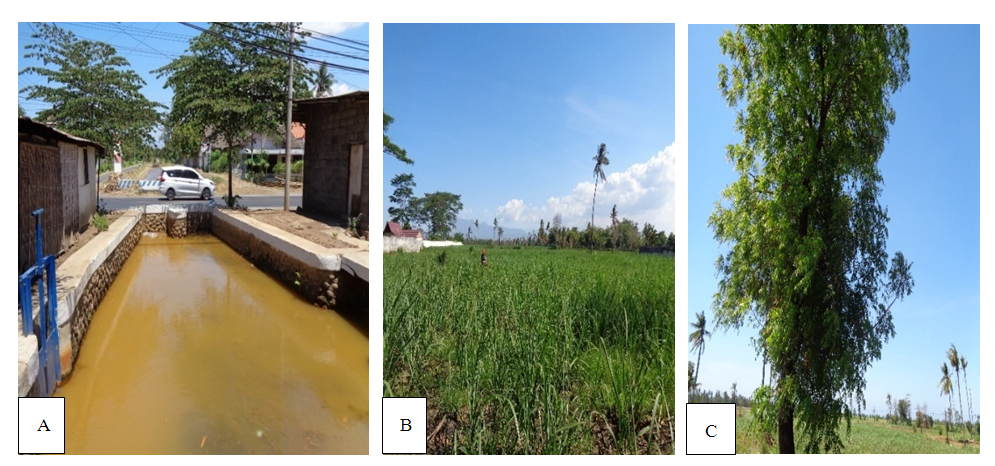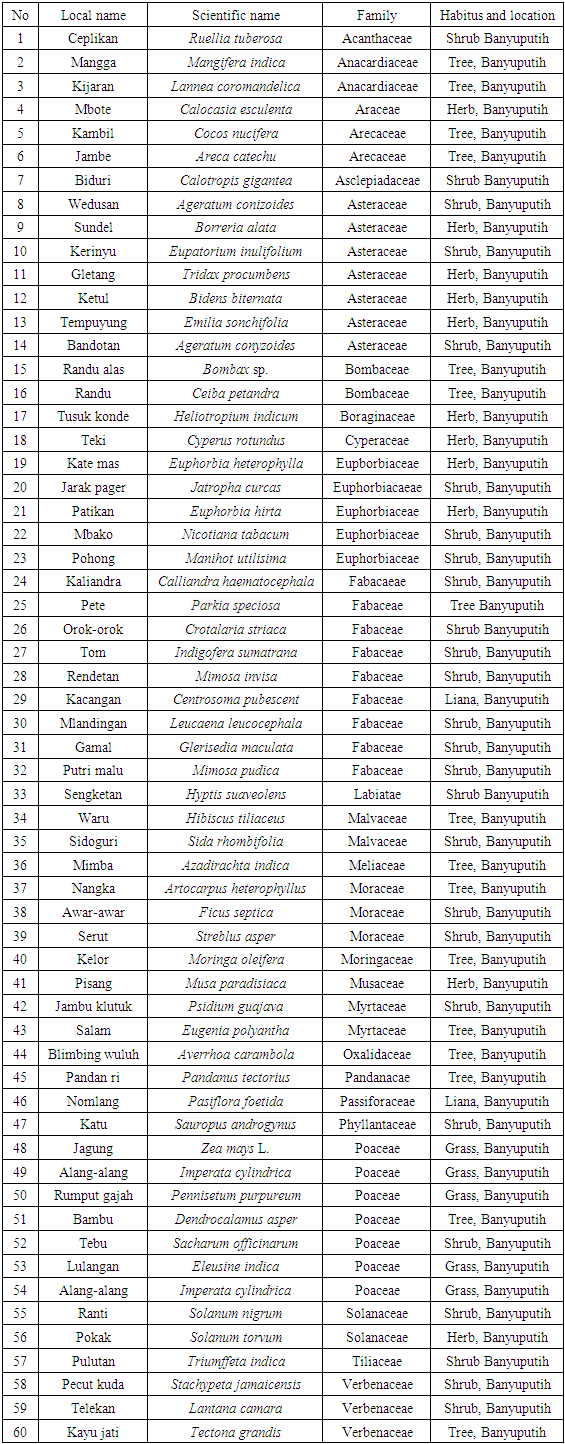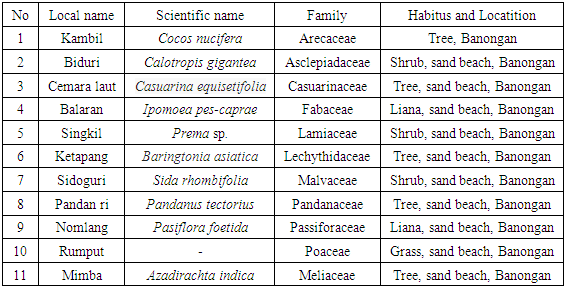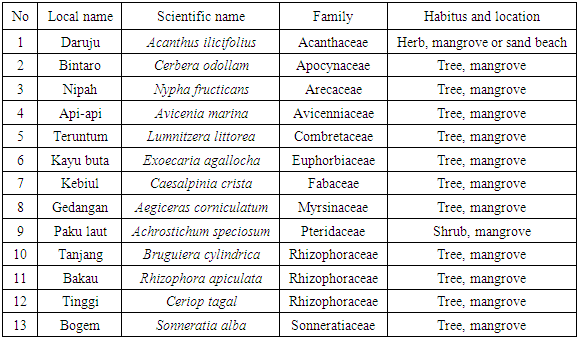-
Paper Information
- Paper Submission
-
Journal Information
- About This Journal
- Editorial Board
- Current Issue
- Archive
- Author Guidelines
- Contact Us
International Journal of Agriculture and Forestry
p-ISSN: 2165-882X e-ISSN: 2165-8846
2020; 10(4): 96-101
doi:10.5923/j.ijaf.20201004.02
Received: Sep. 13, 2020; Accepted: Oct. 15, 2020; Published: Oct. 26, 2020

Potential Diversity of Plant Species Against Sulfur Absorption in the Banyuputih River Situbondo, East Java
1Department of Biology Natural Sciences Brawijaya University, Jl. Veteran, Malang, East Java, Indonesia
2Department of Physics, Faculty of Mathematics, Jl. Veteran, Malang, East Java, Indonesia
Correspondence to: Jati Batoro, Department of Biology Natural Sciences Brawijaya University, Jl. Veteran, Malang, East Java, Indonesia.
| Email: |  |
Copyright © 2020 The Author(s). Published by Scientific & Academic Publishing.
This work is licensed under the Creative Commons Attribution International License (CC BY).
http://creativecommons.org/licenses/by/4.0/

The diversity of plant species not only serves as a barrier to seawater intrusion but also provides protection from land to sea, originating from Mount Ijen flows the Banyuputih river in the Situbondo region, East Java. The Situbondo-Banyuwangi regency area is a strategic area, so it needs to be preserved its environmental ecosystem. The diversity of mangrove forests, natural sand beaches and riverbank vegetation can be an indication of environmental protection and preservation. The diversity of cultivated and wild plant species also has an indication of the pH state. Likewise, the types of flora around the Banyuputih river have an indication that they can reduce the impact of the infiltration of sulfur levels, thus contributing to groundwater sources. This study aims to determine diversity of flora species along the riverbanks and sand beaches in the environment of the highway at the mouth of the Banyuputih river in Situbondo regency, which is allegedly contaminated with sulfur material from Mount Ijen. To support the environmental function, it is equipped with data on the depth of groundwater sources, location elevations and river water’s pH. The methods used in this research were survey, open-ended interviews, semi-structured and in-depth interviews. The survey results are then collected and diagnosed and the scientific name is determined. Species diversity was recorded around Banyuputih river, Banyuputih sub-district including 26 families (60 species), mangroves 11 families (13 species) and Banongan sand beach 8 families (11 species). The sulfur levels along the Banyuputih river indicate that the diversity of flora has the potential to filter sulfur levels, so the water resources can be utilized for living. Meanwhile, the existence of the diversity of coastal forests and mangroves functions as a barrier to sea water intrusion, wind and tsunami.
Keywords: Banyuputih river, Situbondo regency, Flora, Sulfur
Cite this paper: Jati Batoro, Wiyono, Potential Diversity of Plant Species Against Sulfur Absorption in the Banyuputih River Situbondo, East Java, International Journal of Agriculture and Forestry, Vol. 10 No. 4, 2020, pp. 96-101. doi: 10.5923/j.ijaf.20201004.02.
Article Outline
1. Introduction
- Indonesian is an island with an approximately 17.508 islands and length of beaches approximately 81.000 km [5]. There are very large biotic and abiotic in coastal resources. Magrove ecosystems are found in intertidal areas where deposition of sediment occurs [11]. The are dominated by trees, shrub, herb, liana, epiphyte, saprophyte and associated organisms occupying environment at the land or sea. The most important coastal natural resources is mangrove forest. The objectives of this research is to reveal the existence of flora around the Banyuputih river, sand beach and magrove ecosystems in Banyuputih district, Situbondo regency. The area of Banyuputih district is 481.670 km2 consisting of five villages that have sand beaches, river estuaries. Most of the Banyuputih sub-district is flat land with an altitude of 5–60 m above sea level, flat soil conditions and legosol soil characteristics. Most of the people along the Banyuputih river are inhabited by the Madurese and it can be indicated from their language accent. Diversity in the coastal environment of southern Java consists of mangove forest, coastal forest and coral reef forest [4,6]. The relationship between humans and the utilization of biodiversity (organisms) in the environment they live in is known as ethnobotany activity [4,12]. Local wisdom are human behavior that is passed down from generation to generation through stories or tales that are not written by word of mouth [7,4,12]. Mount Ijen is a volcanic mountain, located between Banyuwangi and Bondowoso districts and has an altitude of 2.386 m above sea level (ASL). The content of sulfur and calcium elements (Sulfur and Calcium) which is brought from the top of Mount Ijen is a problem that can be overcome for health problems of organisms. The people of the coastal area of Situbondo district-Banyuwangi are the environment affected by the disturbance of sulfur elements [13,14]. The research reveals that the diversity of flora is related to the intrusion of Sulfur levels along the Banyuputih river.
2. Materials and Methods
- The study was conducted through surveys and direct observations in muara sungai Banyuputih Situbondo-Banyuwangi, in May-October 2020 (Fig. 1). This research methods are collecting the plant materials, drying, mounting, preparation and preservation of plant specimens [1,3,8, 11]. The identification and nomenclature of the listed plants were based on the Flora of Java and Flora Malesiana [3,6]. The methods employed were survey, open-ended interviews, semi-structured and in-depth interviews [4]. Meanwhile, the altitude of the research location was carried out using GPS. In determining the water condition: color and pH of the water in Banyuputih river are using pH paper.
 | Figure 1. Map of Situbondo Regency (star-study area) |
3. Results and Discussion
- Banyuputih river environmentMadurese peoples generally engaged in the agricultural sector, rice processing, moor and yards. Therefore, along the Banyuputih river, various cultivated plants are planted such as: tebu (Sacharum officinarum), banana (Musa paradisiaca), mango (Mangifera indica), pete (Parkia speciosa), coconut (Cocos nucifera), cassava (Manihot utilisima), rice (Oryza sativa), corn (Zea mays) etc. (Table 1). The diversity of cultivated plants and wild plants as well as environmental factors such as soil and river flow in the area have an indication that it can reduce the impact of sulfur infiltration, thus contributing to water sources. The smell of sulfur around the Banyuputih neighborhood has decreased compared to the location near Mount Ijen (Wiyono, 2017; personal interview, 2020). Sugarcane cultivation has superior growth with very good sugar content, while irrigation uses Banyuputih river. [2,12] reported local wisdom in customary law is used as the main source in managing river resources.
|
 | Figure 2. A. Banyuputih river, Daendeles road. B. Research locations for sugarcane cultivation (Sacharum officinarum) and C. Mimba trees (Azadirachta indica). Photo, J. Batoro |
|
|
4. Conclutions
- Species diversity was recorded around Banyuputih river, Banyuputih sub-district covering 26 families (60 species), mangroves 11 families (13 species) and Banongan sand beach 8 families (11 species). Sugarcane, tebu (Sacharum officinarum) cultivation has superior growth with very good sugar content, while irrigation uses Banyuputih river. The research reveals that the diversity of flora is related to the intrusion of Sulfur levels along the Banyuputih river. The existence of the diversity of coastal plants and mangroves serves as a barrier to intrusion of sea water, wind and tsunami.
ACKNOKLEDGEMENTS
- The author would like to express their gratitude to Deparment Physics and Department Biology FMIPA Brawijaya University financial (Doctoral grant program) supports during our research. The author would like thank to dean LPPM, Dr. Bambang Susilo MP, and also Mr. Arifin, thesis students, Mr. Purnomo (laboratory assistant) and Fauzan photos collection for using specimen during this research.
 Abstract
Abstract Reference
Reference Full-Text PDF
Full-Text PDF Full-text HTML
Full-text HTML


